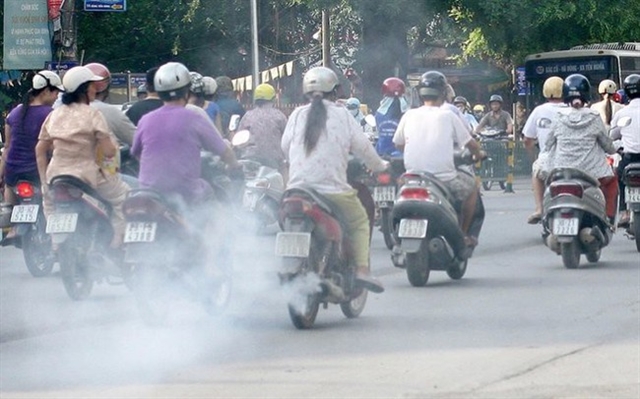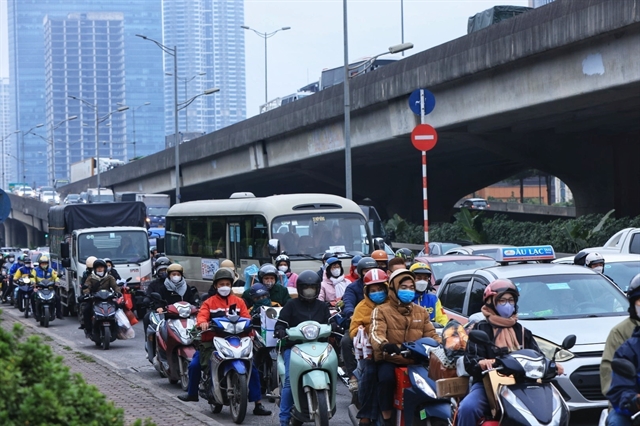 Environment
Environment

 |
| Congested traffic on Belt Road No 3 in Hà Nội. — VNA/VNS Photo |
HÀ NỘI — While the land area for traffic in Hà Nội only increases by around 0.3 per cent per year, the number of private motorbikes and cars rises 4-5 per cent and 10 per cent per year, respectively.
If the growing rate of private vehicles is not controlled, the city will experience more severe traffic congestion.
By December 2024, the city's total road length – excluding small lanes and alleys – was approximately 23,420km, according to the municipal Department of Transport. This includes five beltways and expressways, 11 national highways, 128 provincial roads, 1,220 urban roads, 2,310 intersections and 585 bridges and tunnels.
With an average annual growth rate of 0.3 per cent, the land area used for traffic in Hà Nội has so far reached 12.13 per cent. The city's strategy states that it must reach 20-26 per cent for key urban areas by 2030.
In Hà Nội, approximately 21.55km of urban railway have been placed into service, comprising 8.5km of the elevated portion of the pilot urban railway line of Nhổn - Hà Nội Railway Station section and 13.05km of the 2A Cát Linh - Hà Đông urban railway line.
The bus network consists of one BRT bus route and 154 standard bus routes with 2,279 vehicles.
The rate of public passenger transport has reached 19.5 per cent. By 2030, it must reach 30-35 per cent.
Meanwhile, the current population of Hà Nội is over eight million people, not including about 1.2-1.5 million people from other provinces and cities who regularly live, work and study in the city.
The whole city has more than 9.2 million vehicles of all kinds operating, not including vehicles of central agencies. Among those, the city is managing more than eight million vehicles of all kinds, including 1.1 million cars and 6.9 million motorbikes.
There are about 1.2 million private cars and motorbikes from other provinces and cities also operating in the city. The general growth rate of vehicles is about 4-5 per cent per year, about 11-17 times the growth rate of road expansion.
The number of private cars has increased by about 10 per cent per year, more than 30 times the growth rate of land for traffic.
The population density of Hà Nội is 8.2 times the national average, with an average of 2,398 people per square metre, according to the Department of Transport. The average annual mechanical population growth rate in the city is still 1.4 per cent, which is a fairly high pace.
Along with the increase in personal vehicles dozens of times higher than the infrastructure growth index, the traffic density on many routes and intersections stays high, especially during rush hours. The actual traffic volume on many routes and intersections exceeds the designed capacity.
It is estimated that the traffic volume on Nguyễn Trãi Road is 2.5-3.2 times the design volume; Khuất Duy Tiến – Nguyễn Xiển Road is 4.3-4.9 times; Lê Văn Lương Road is 2.7-3.3 times.
Master of Urban Management Trần Tuấn Anh said: "With the rapid increase of personal vehicles and traffic density overload, no infrastructure system can keep up to meet the demand. Traffic congestion in Hà Nội will become more and more complicated."
When the roads are overloaded many times, no matter how many synchronous measures are taken such as traffic regulation, strict punishment, moving schools and hospitals out of the city centre will not prove immediate results, he told Kinh Tế&Đô Thị (Economic and Urban Affairs) newspaper.
Anh added: "The synchronous implementation of solutions to reduce traffic congestion is necessary and must be persistent as well as promoted more quickly.
"However, in the immediate future, the city needs to consider priority measures to regulate traffic in accordance with the existing infrastructure capacity.”
Only by limiting private vehicles and returning the roads to their designed capacity can traffic congestion be resolved. In the current context, low-cost cars and incentives on registration fees can stimulate the growth of the automobile industry for a period, but its consequences on traffic are long-term and extremely severe, he said.
Master of Economic Management Hoàng Thị Thu Phương suggested fiscal measures to restrict private automobiles.
She said the city must go back to its original plan to restrict private vehicles of all kinds, including cars and motorcycles.
"Given that the number of cases increases more than 30 times compared to the land area for traffic, cars need to be considered to be limited," Phương said.
It is possible to continue to impose high taxes on private cars registered in large urban areas to somewhat limit the increase. Some areas should ban cars and motorbikes from circulating by hour or charge a fee to enter the inner city, she said.
Many experts believe that Hà Nội needs to focus on two urgent solutions, managing traffic demand and limiting private vehicles, including electric vehicles.
Master of Urban Management Phan Trường Thành said traffic demand management or travel demand management is the application of strategies and policies to control the balance of supply and demand for travel in space or at a specific time, by encouraging people to limit the use of unnecessary personal vehicles, encourage public transport and non-motorised vehicles.
Others believe that limiting private vehicles is also a solution to encourage people to use other alternative means of transport. The city should open priority spaces for buses in order to better meet travel needs, while creating incentives for people to limit the use of private vehicles. — VNS




